- Home
- The Autumn Garden
- Fall Perennials
Fall Perennials (and a few annuals
and biennials, too)
Extend the Gardening Season
Fall perennials breathe new interest and life into your garden at the end of the season just when everything is beginning to slow down or look ratty. Some of the loveliest flowers bloom at this time of year and they complement the changing leaves beautifully.
There are a lot of choices, too! Some autumn flowers that we think of as fall perennials actually begin blooming at the beginning of summer and continue into fall, while others wait patiently to reveal their beauty at the end of the season, and many continue on until frost puts an end to their play.
Aconitum carmichaelii, azure monkshood, Zones 3-7. These curious hooded flowers resemble ancient soldiers helmets rather more than monk’s hoods from which they get their common name, but maybe “helmethood” wouldn’t quite have the same aura of mystery. Nevertheless, monkshood is one of the latest-blooming fall flowers, and the rich blue is outstanding in the border. However, be aware that monkshood is also poisonous in all parts and should definitely be kept away from areas where small children play. The positive side to its toxicity is that deer avoid it. A carmichaelii grows to about 2 to 4’ tall with deeply cut foliage and prefers full sun to semi-shade, rich moist soil, and good drainage. Monkshood grows best in areas with cooler temperatures.
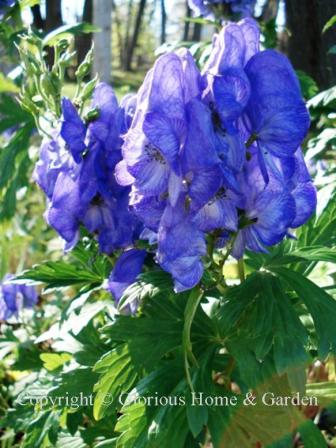 Aconitum carmichaelii
Aconitum carmichaeliiActaea simplex, bugbane, Zones 3-7. This late-summer-to-fall blooming perennial has undergone a name change. Formerly known as cimicifuga, it is a great addition to the late autumn garden no matter what you call it. The deeply cut foliage is attractive and the pure white candle-like racemes glow in the border. This species is said to tolerate dry shade well, but would prefer good humusy garden soil--moist, but well-drained--in part to full shade. 'White Pearl' is a lovely cultivar, 'Carbonella' has purple foliage, and 'Hillside Black Beauty' has dark leaves and stems with pale pink flowers.
Anemone × hybrida, Japanese anemones,
Zones 5-7. What a lovely plant this is in the late summer to fall
garden--graceful, colorful and charming. Some of the best cultivars are
'Andrea Atkinson,' semi-double white with green eye, 'Honorine Jobert' (2016
Perennial Plant of the Year ®), single white; 'Prinz Heinrich,' semi-double rose-pink; 'Queen Charlotte,' semi-double pink; 'September
Charm,' single pink; and 'Serenade' also pink. Attracts butterflies. One of
the best fall perennials. And the seedpods are very curious, too, looking like cotton balls with tiny seeds like strawberries.
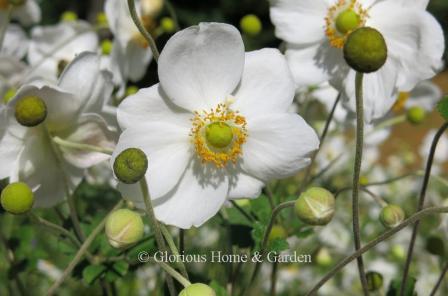 Anemone x hybrida 'Honorine Jobert'
Anemone x hybrida 'Honorine Jobert'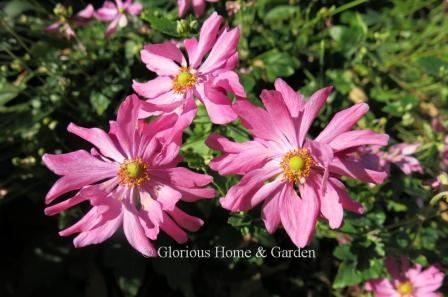 Anemone x hybrida 'Prinz Heinrich'
Anemone x hybrida 'Prinz Heinrich'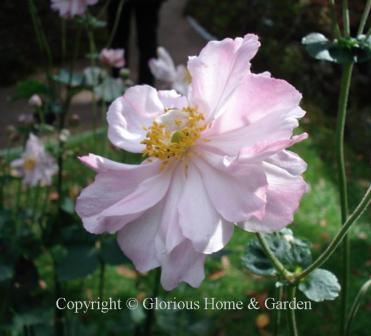 Anemone x hybrida 'Queen Charlotte'
Anemone x hybrida 'Queen Charlotte'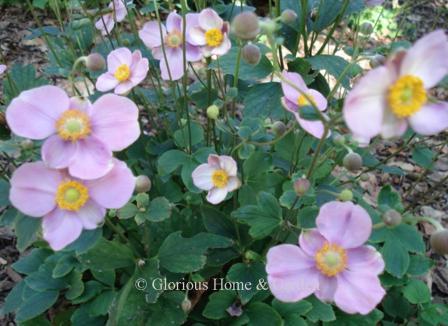 Anemone x 'September Charm'
Anemone x 'September Charm'Angelica gigas, purple parsnip, Zones 5-7. This biennial will reseed and behave as a perennial if it's happy (moist, sunny areas). A large (3-5') plant, it needs room. In the back of the border the large round purple flower heads will be a standout in late summer into fall.
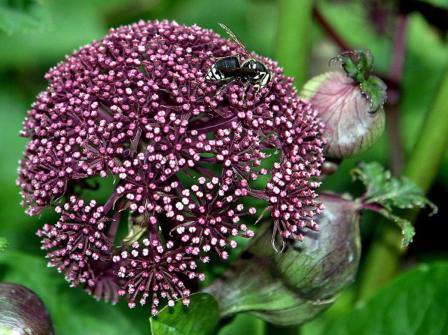 Angelica gigas
Angelica gigasAsters (See also Symphyotrichum)
Aster tataricus,
Tatarian daisy, Zones 4-8. This fall perennial is a tall stately plant
(3-7') for the back of the border that seldom needs staking. Dense
clusters of soft lavender flowers with yellow centers form atop tall
stalks rising from a leafy base. A shorter cultivar called 'Jin-Dai,' reaching 3-4' tall is shown below.
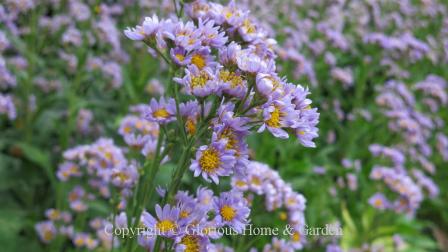 Aster tataricus
Aster tataricusBoltonia diffusa, smallhead doll's daisy, Zones 5-9. This native of the southeastern U.S. produces mounds of tiny white daisy flowers in great abundance. Great filler plant to use around other perennials.
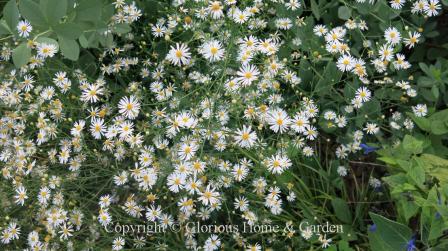 Boltonia diffusa
Boltonia diffusaCeratostigma plumbaginoides, leadwort, Zones 5-8. Leadwort is an excellent ground cover that produces brilliant blue flowers in late summer into early fall and forms a spreading mound via rhizomes. As a bonus, the leaves turn bronze-red in the autumn.
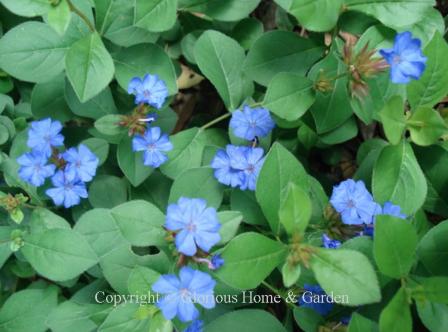 Ceratostigma plumbaginoides
Ceratostigma plumbaginoidesChrysanthemums
Chrysanthemum × morifolium, hybrid chrysanthemums,
Zones 5-9. A larger cousin of asters, chrysanthemums are fall blooming
perennials that pack a dependable punch in classic autumn shades of
white, yellow, gold, bronze, pink, red and purple. They come in many
flower forms as well, but most of those sold for the garden or
containers are the cushion or daisy types. They are easily grown, and
spread to increase in size where happy--that is in full sun and good,
well-drained garden soil. Pinch them back a couple of times in spring
and early summer to make compact plants and produce more flowers. Enjoy
in containers and plant them in the garden when they finish blooming.
A good garden variety, 'Cambodian Queen,' soft pink is pictured, and below that is 'Lava,' a bright yellow exhibition spider mum.
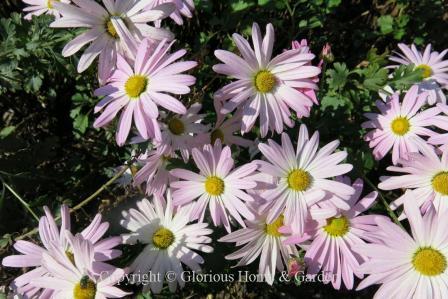 Chrysanthemum x 'Cambodian Queen'
Chrysanthemum x 'Cambodian Queen'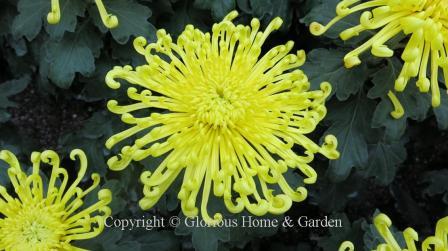 Chrysanthemum x morifolium 'Lava'
Chrysanthemum x morifolium 'Lava'Chrysanthemum pacificum, silver and gold, Zones 5-9. This late fall perennial is attractive in the garden even when it's not in bloom with its green foliage edged in silver. The plants are topped with small bright yellow flowers in late fall. Plant in full sun in moist, but well-drained soil rich in organic matter.
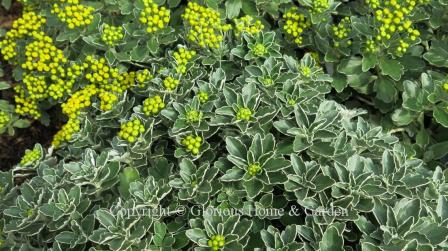 Chrysanthemum pacificum
Chrysanthemum pacificum
Plant of the Month
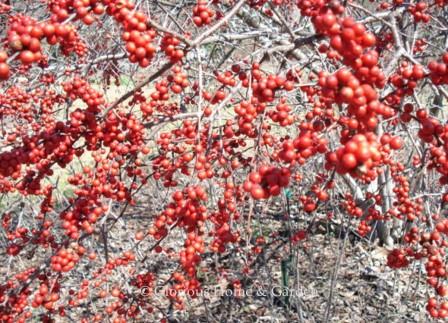
Ilex verticillata
Winterberry holly
Updated new USDA Plant Hardiness Zone Map 2023.